Climate change hits the Clare Valley
Spring Gully Conservation Park was hard hit following the exceptional
summer of 2007/08, with heavy damage particularly to the red stringybark
trees
If you find an error on any of these pages you will be doing me a favour
by pointing it out so that I can correct it.
My aim is that everything that is not plainly an opinion should be true.
Contact: email daveclarkecb@yahoo.com
This page created 2008/05/11, modified 2009/07/28
|
The red stringybark tree community, that has lived in the Clare hills for
thousands of years, has suffered very badly from heat and drought.
It appears likely that, in the next few decades, they will go from
being the dominant species in some microenvironments to becoming a scattered
remnant in only small areas,
predominantly with southerly aspects.
|
|
|
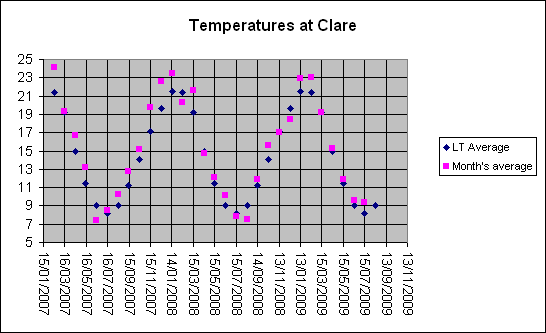
| |
The blue diamonds are long-term average monthly temperatures for Clare.
Pink squares are averages of the temperatures measured in particular months.
Note that in most cases the temperatures (and in particular those of the
spring and summer of 2007/08) were higher than those for average months
(pink plots are above blue plots) –
evidence that the climate is warming in the Clare Valley.
On average the temperatures during the whole of the period shown on the
graph were 0.79° warmer than the long-term average.
These data are extracted from Bureau of Meteorology records available on
the Net.
| |
|
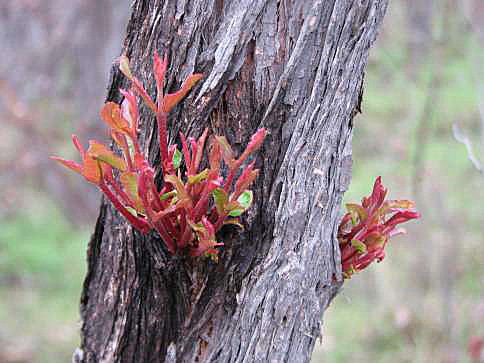
| |
Epicormic growth on one of the trees that previously appeared dead,
photo July 2008
| |
Spring Gully was first gazetted as a Wildlife Reserve in 1962 and later
proclaimed as a Conservation Park to protect a significant population of
red stringybark trees.
It is at Latitude -33.91°, Longitude 138.59°, near Clare in the
state of South Australia.
The stringybarks (Eucalyptus macrorhyncha) had, thousands of
years previously, become separated from the remainder of the species which
are in eastern Victoria and eastern NSW, see
Wikipedia.
Many of these trees have suffered badly from heat and drought, particularly
in the summer of 2007/08, and an unknown proportion have died.
Environmentalist have been predicting for years that as temperatures
rise due to climate change,
species on hills or mountains would tend to die-out at lower
altitudes and gradually spread toward higher altitudes, where the lower
temperatures would suit their needs.
Of course species isolated on or near the tops of hills and mountains would
have nowhere to go; they would become, at least locally, extinct.
It seems that the red stringybarks of Spring Gully Conservation Park have
taken a big first step on the journey toward that local extinction.
It is more a guess than an estimate, but something like a third to a
half of the trees have come very close to dieing, or have died.
As these trees are at or near the top of the Clare hills, the species cannot
migrate to a cooler habitat at a higher altitude.
I revisited the park on 2008/07/27 and observed epicormic growth on many
of the trees that earlier appeared to be dead.
Interestingly the shooting is on the northern side of the tree trunks
and larger branches, although apparently on all sides of smaller branches.
Another visit on
2009/07/26 showed that many of the trees that
had produced epicormic growth had died.
The Spring and early Summer of 2007 were dry in the Clare Valley of
South Australia, a premium and famous wine-growing region.
To make matters worse the first three months of 2008 were exceptionally
dry; only about 16mm of rain fell in this period.
The final blow was an all-time record long heatwave in mid-March.
The results can be seen in the photos below...
|
|
|
This section added 2009/06/28
|
|
|
|
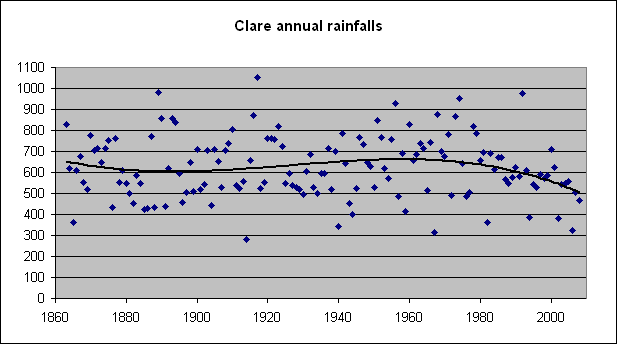
| |
Note the decline in rainfall in recent years
|
|
The graph at the right is made up of Bureau of Meteorology data taken from
Clare Post office (1863 to 1994) and Clare High School (from 1995 onward).
The average annual rainfall from 1863 to 1990 was 632mm, from 1991 to
2008 it was 557mm, 75mm lower.
In the period from 1994 to 2008 the average was 525mm, 107mm lower than
the 1863 to 1990 average.
The curved line was calculated as a line of best fit to the data.
The steepness and persistence of the decline in rainfalls since about 1970
seems to be unprecedented in the data.
Plainly the declining rainfalls, combined with higher temperatures,
will stress perennial plants.
Worryingly, the decline in rainfall seems to be becoming steeper, there
is no reason to think that the bottom has been reached.

|
The trees with the dark bark in this photo are red stringybark
(Eucalyptus macrorhyncha).
The live tree is, I believe, a bluegum (Eucalyptus leucoxilon).
Wyman's Track
11th May, 2008; Spring Gully Conservation Park
|

|
The trees with the dark bark on the left of this photo are red stringybark.
Those with the smooth white bark on the right could be bluegums.
Most of the bluegums, perhaps the most common Eucalypt in the Clare Valley,
are quite healthy.
The difference is remarkable; thousands of stringybarks are dead or
near dead, more thousands of bluegums going on the same as ever.
Wyman's Track
11th May, 2008; Spring Gully Conservation Park
|

|
Another stand of Eucalyptus macrorhyncha.
Note that these trees are mainly very young.
Many of the trees that appear dead in this photo will recover in time.
Wyman's Track
11th May, 2008; Spring Gully Conservation Park
|
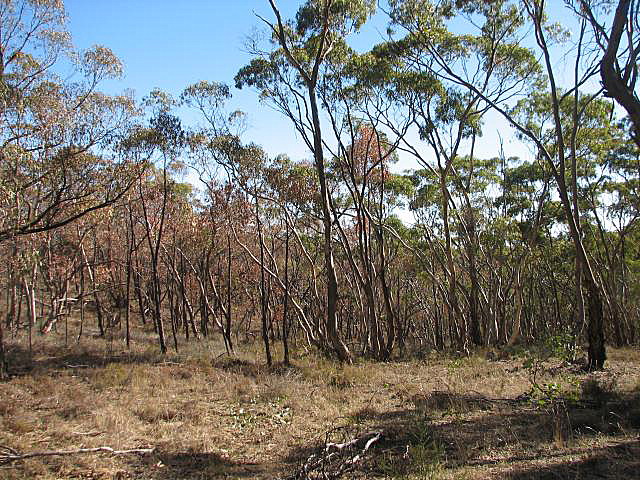
|
Most of the trees on the left are highly stressed stringybark, while the
trees on the right (bluegums?) have survived with little apparent damage.
There is always a danger that when a major species is set back to this
extent that the area will be colonised by weed species such as
Spanish lavender.
Wyman's Track
11th May, 2008; Spring Gully Conservation Park
|

|
The majority of the trees in this photo are red stringybark.
It seems that those on the right, being less crowded together, have
survived well because they had a greater volume of soil from which to access
water.
Wyman's Track
11th May, 2008; Spring Gully Conservation Park
|
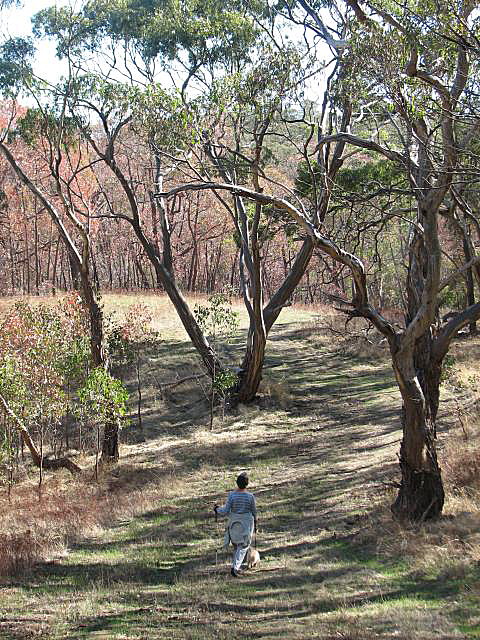
|
Live bluegums(?) in the foreground, near-dead stringybark in the distance
On the track along the roadside
11th May, 2008; Spring Gully Conservation Park
|

|
The tree near the center of this photo is exceptionally large for the
red stringybarks of Spring Gully.
It appears quite dead (but may recover given sufficient time).
The green shrubs are Acacia.
On the track along the roadside
11th May, 2008; Spring Gully Conservation Park
|

|
Thankfully the stringybarks along the ridgetop walk were not in quite such a
bad way as those on the Cascades Trail and Wyman's Trail.
However, many are near dead even here too.
Ridgetop walk
12th May, 2008; Spring Gully Conservation Park
|

|
This beautiful stringybark, on the park boundary at the end of the ridgetop
walk, looks very healthy.
Again, this is probably because it is not as crowded as where many have
been stressed to the point of seeming to be dead.
Ridgetop walk
12th May, 2008; Spring Gully Conservation Park
|

|
It was easy to find red stringybarks on the Clare ranges in May 2008.
They seemed to mostly be dead and were easy to see because of their pale
leaves.
I now know where there were scattered patches of stringybark that I
didn't know were there.
What a pity to learn of the existence of something by its apparent death!
We can only hope that they recover and that the next bad summer does not
come for a few years yet.
12th May, 2008; Adjacent Bennys Hill Road
There appear to be a number of other similar small patches of 'dead'
stringybarks along the same ridge, on the western side of Clare.
Most of these are on private property.
|
|
|
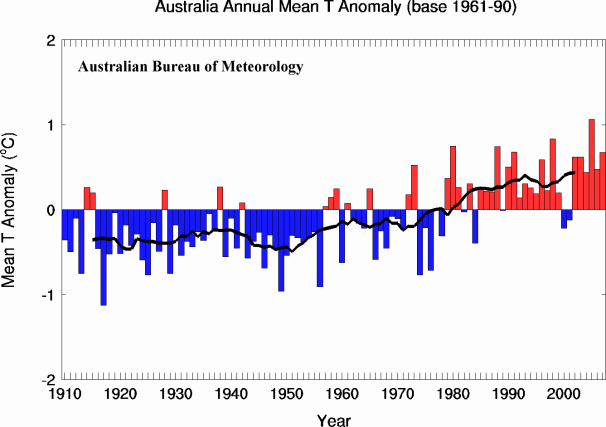
| |
Australian mean annual temperature anomaly - credit: Aust. Bureau of
Meteorology, 2008
|
|
It might be argued that similar dieings could have taken place in the
past every fifty or hundred years or so, whenever there was a particularly
harsh period of drought and/or heat; that this event might not be unique.
Even if most of the trees recover, the community could not suffer this
sort of blow at all frequently without there being a great competative
advantage given to the other species in the community.
If this had happened in the past, at more than very rare intervals,
the Eucalypts other than stringybarks would have taken over entirely from
the stringybarks.
The graph on the right shows the change in average annual temperatures
from 1910 to about 2007.
For each year it shows how the average temperature for that year compares
to the average temperature for the base period, 1961-1990.
Years below that average are represented by blue bars going downward and years
above average temperature are represented by red bars going upward.
The length of the bars show how far the temperature of that year deviated
from the average.
The stringybark dieing was a freak event - to some extent.
There was no dieing last year or the few years before that, even though
climate change hasn't heated the world much in that time.
But, looking at the graph and considering that there is a trend for
each year to be a little warmer than the one before, how could any
reasonable person doubt that the dieing is a combination between global
warming and a freak event.
Freak events such as this are going to be more common as temperatures
rise.
Of course I am not going to convince the remaining climate change skeptics.
There is a hard core of these who will die believing that it is not
happening or that it is 'normal' or that it is nothing to do with human
activity.
2009/07/26

|
My wife and I visited Spring Gully again on 26th July 2009, a
year and a couple of months after the visit on which most of the photos
above were taken.
Many of the stringybarks had not recovered.
|

|
Quite a few of the trees that had produced epicormic shoots had not survived.
Here the tree on the right of centre has survived, while its neighbour left
of centre has died after shooting.
|

|
Another view of an area with many dead trees over a year after the main
'dieing' event.
|
Isn't it about time that we, as individuals and as a society, started taking
climate change seriously and doing something about it - changing our
life-styles, closing down fossil-fuelled power stations?
What more must we loose before the apathetic majority change from their
big four-wheel-drives to small fuel-efficient cars or even bicycles and our
governments start spending more on renewable energy than on coal?
|
















